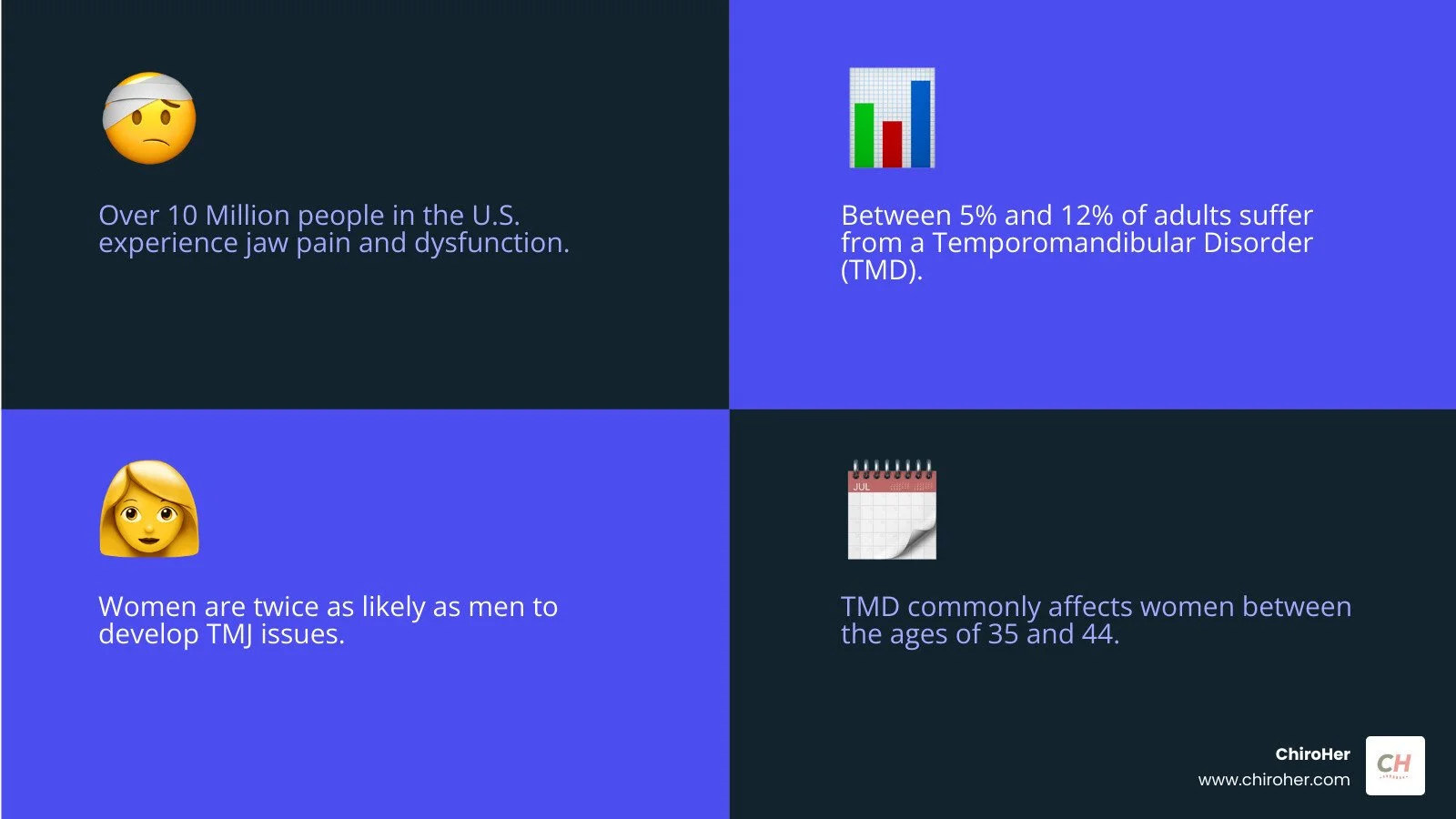From Clench to Calm: Effective Strategies for Jaw Relief
Why Your Jaw Hurts and What You Can Do About It
Jaw discomfort relief starts with understanding what's happening in your temporomandibular joint (TMJ). Here are some simple strategies that work.
Quick Relief Strategies for Jaw Discomfort:
Apply moist heat or ice packs for 15-20 minutes several times daily
Eat soft foods and avoid chewy, crunchy items
Practice gentle jaw stretches with your tongue on the roof of your mouth
Stop habits like gum chewing, nail biting, and teeth clenching
Keep your teeth slightly apart when your mouth is at rest
Manage stress through deep breathing and relaxation techniques
Your temporomandibular joint connects your lower jaw to your skull, allowing you to talk, smile, and eat. When this complex joint has a problem, it can cause significant pain. More than 10 million people in the U.S. live with some form of temporomandibular disorder (TMD), with women being twice as likely as men to develop these issues.
Common signs of TMD include clicking or popping sounds, difficulty opening your mouth, pain when chewing, headaches, and earaches. The pain can be in the jaw, the joint, or surrounding muscles. Causes vary from teeth grinding and stress to poor posture from desk work or an injury.
The good news is that most jaw pain responds well to simple treatments you can start at home. Research shows that most patients find relief through self-care and lifestyle changes.
Hi! I'm Dr. Michelle Andrews, founder of ChiroHer in Oklahoma City. I've helped hundreds of patients find long-term jaw discomfort relief with personalized, holistic care that addresses the root causes of TMD.
Your How-To Guide for Jaw Discomfort Relief
When jaw pain interferes with your life, it's frustrating. The good news is that most people find relief with simple changes at home. I've seen many patients improve by incorporating a few practical strategies into their routine. Let's walk through some effective approaches.
Gentle Exercises to Soothe Your Jaw
Your jaw muscles respond well to gentle, consistent movement. The right exercises can improve range of motion and ease pain. Important: if any exercise causes pain, stop immediately.
The Relaxed Jaw Exercise: Rest your tongue on the roof of your mouth behind your upper front teeth. Let your teeth separate slightly, releasing jaw tension. Hold for a few seconds while breathing deeply. This helps you recognize what a relaxed jaw feels like.
Goldfish Exercises: Place one finger on your chin and another on the TMJ area in front of your ear. Slowly drop your lower jaw halfway, then close it. You should feel a mild stretch. Repeat six times in a row, six times a day.
Chin Tucks: Sit or stand tall. Gently pull your chin straight back, creating a double chin, to feel a stretch in the back of your neck. Hold for three to five seconds and repeat ten to fifteen times. This helps correct forward head posture, a common contributor to jaw strain.
Scientific research on jaw exercises supports these movements for managing TMJ symptoms. Consistency is more important than intensity.
Dietary and Habit Modifications
What you eat and how you use your jaw matter. Mindful adjustments can give your TMJ a break to recover.
Diet: For a few weeks, switch to a soft food diet. Think smoothies, yogurt, soups, and mashed potatoes. Avoid hard, chewy, or crunchy foods like bagels, tough meats, raw carrots, and gum. Cut food into smaller pieces and chew on both sides of your mouth.
Heat and Cold Therapy: For sharp pain and swelling, apply an ice pack wrapped in a cloth for 10-15 minutes. For dull aches and stiffness, use a warm, moist washcloth for 15-20 minutes to relax muscles.
Sleep Posture: Sleeping on your back helps keep your head, neck, and jaw in a neutral position. If you sleep on your side, use a supportive pillow and avoid pressing your jaw into your hand.
Habits: Stop chewing gum, biting nails, or chewing on pens. Avoid cradling your phone between your shoulder and ear; use a headset instead. Be aware of clenching or grinding your teeth (bruxism), which often happens during the day or at night.
For more insights, check out our blog post with more info about Jaw Pain.
The Role of Stress and Posture in Jaw Discomfort Relief
Your stress levels and posture have a huge impact on your jaw. Many of us clench our jaw when stressed, and forward head posture from screen time puts constant strain on the TMJ.
Managing stress is key for jaw discomfort relief. A simple, effective technique is deep breathing. Inhale slowly through your nose for a count of five, then exhale slowly through your mouth. This activates your body's relaxation response. Scientific research on relaxation techniques shows that breathing exercises can reduce pressure in jaw muscles. Mindfulness and progressive muscle relaxation are also helpful.
Now, let's talk about posture. When your head juts forward, your jaw follows, stressing the TMJ. Adjust your workspace so your monitor is at eye level and your chair supports your back. Periodically check your posture: pull your shoulders back and down, lift your chest, and tuck your chin to align your head over your spine. These small adjustments add up to significant relief.
By addressing both stress and posture, you support your overall wellbeing. For more information, visit our page on more info about TMJ.
When to Seek Professional Help
While self-care strategies work for many, sometimes jaw pain requires professional help. It's important to know when to reach out so you don't have to suffer in silence.
Recognizing Red Flags for Jaw Pain
Your body tells you when something needs more attention. See a healthcare provider if you experience:
Persistent pain: Your jaw has been bothering you for more than a week or two despite home care.
A locked jaw: Your jaw gets stuck in an open or closed position, or you can't open your mouth fully. This requires immediate attention.
Severe headaches or dizziness: If these symptoms are debilitating, they need to be evaluated.
Pain affecting daily life: You're struggling to eat, sleep, talk, or focus at work due to jaw discomfort.
When self-care fails: You've been diligent with home strategies without seeing improvement.
In rare cases, jaw pain can be a medical emergency. Call 911 if jaw pain spreads from your chest or shoulders (possible heart attack) or follows a severe injury (possible broken jaw).
Exploring Professional Treatment Options for Jaw Discomfort Relief
At ChiroHer, we use a whole-person approach to address the underlying causes of your jaw discomfort. Chiropractic care can be very effective for TMJ issues. Misalignment in your upper neck can strain your jaw joint, and gentle spinal adjustments can restore proper alignment and reduce that stress.
We also use manual therapy on the muscles in your neck, shoulders, and jaw, along with gentle mobilization techniques to improve joint movement. Posture correction is another cornerstone of our approach, and we provide personalized exercises and ergonomic guidance. If you're curious, read our article Can a Chiropractor Help with TMJ. We also offer acupuncture and therapeutic exercises. Learn more on our chiropractic care page.
Physical therapy and custom-fitted oral splints or night guards from a dentist are other excellent options that can work alongside chiropractic care.
Advanced and Long-Term Solutions
For severe or chronic TMJ disorders, other options may be considered if conservative treatments don't work. These can include:
Medications: Over-the-counter pain relievers, prescription anti-inflammatories, or muscle relaxants.
Injections: Corticosteroid or Botox injections can reduce inflammation and relax overactive muscles.
Surgery: This is a last resort for clear structural problems, after all other methods have been tried.
At ChiroHer, I work with specialists throughout Oklahoma City, Yukon, Edmond, and surrounding areas. This collaborative approach ensures you get comprehensive care. We are here to support you on your way to long-term jaw discomfort relief.
Don't let jaw pain control your life. Schedule a consultation with us today to explore your options for relief.
Building Trust: What Science Says About Jaw Discomfort Relief
When you're in pain, you need solutions backed by solid research. At ChiroHer, we are committed to using the latest scientific findings to offer you effective and safe jaw discomfort relief.
The medical community has learned that conservative care works. Organizations like the National Institutes of Health emphasize starting with non-invasive approaches like gentle exercises, dietary changes, and stress management. The good news is that most people find significant relief with these methods.
TMJ disorders are complex, stemming from muscle tightness, joint problems, stress-related clenching, or postural issues. This is why a thorough assessment is so important for creating a treatment plan that addresses your specific needs. Research supports physical therapy and stress management as key components of effective TMD treatment.
The research is also clear about being cautious with aggressive treatments. Surgical interventions that permanently change your bite have not always proven effective and can sometimes make symptoms worse. We believe in exhausting conservative options first.
We combine evidence-based chiropractic techniques with broader medical knowledge to give you comprehensive care grounded in science. For more information from trusted sources, see what the Cleveland Clinic on TMJ and Mayo Clinic on TMJ Disorders have to say.
Your trust matters to us. That's why we provide care that is not only personalized but also firmly rooted in what science tells us works best for jaw discomfort relief.
This guide is for informational purposes and is not a substitute for already established medical advice from your healthcare provider.





